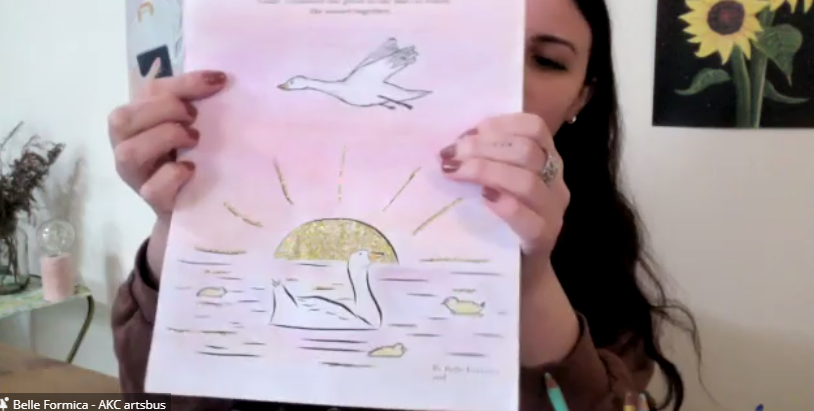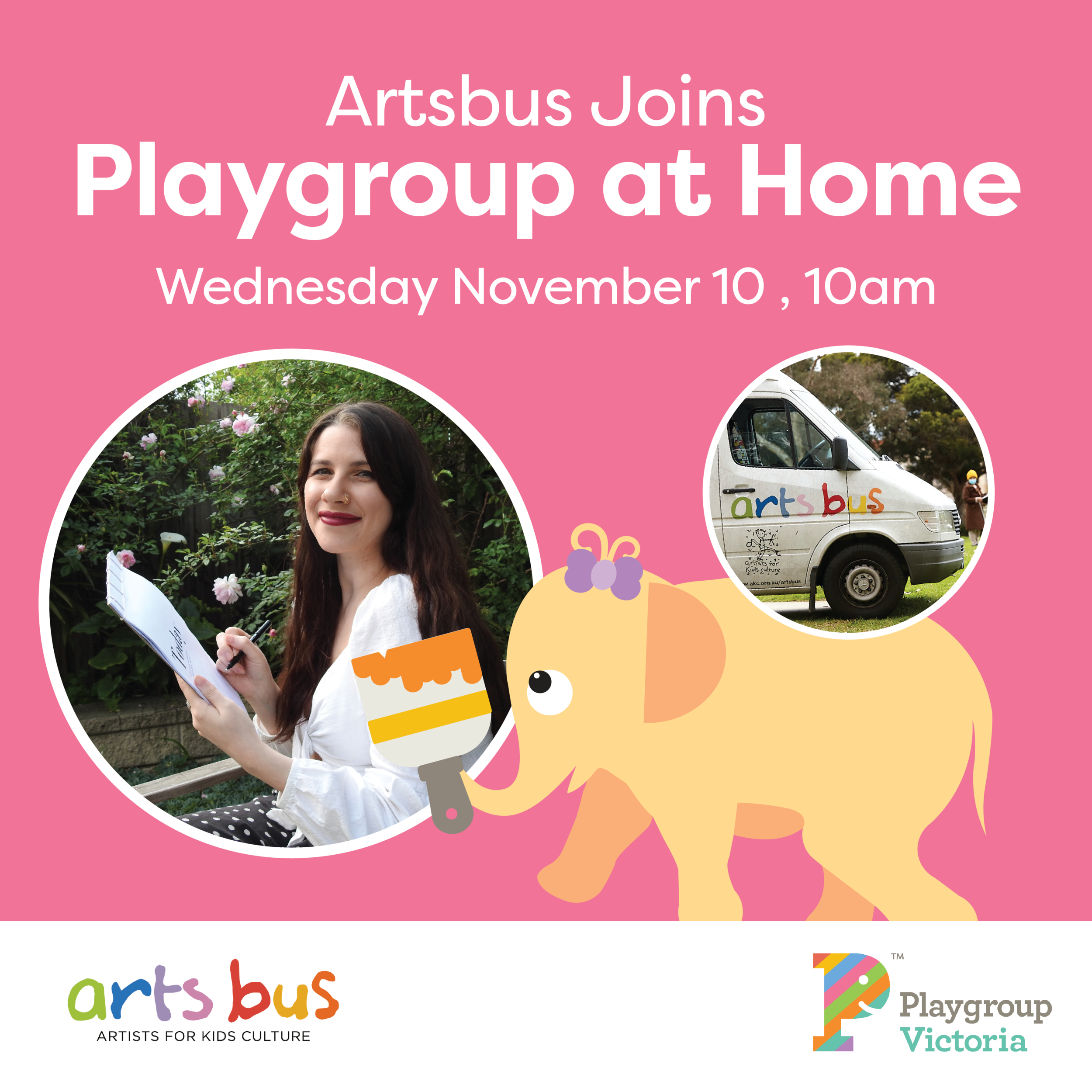artsbus
Cultivating Community, Connection and Care through Creativity
Often moments of joy and transcendence are awoken during the creative process. When this is unexpected, it can take you, especially young children, quite by surprise. While experimenting, looking, observing, trialling, making and creating, young children make sense of the world around them and indeed themselves.
For both Gen Townsend and Belle Formica, early childhood experiences making their own types of art, led them to think more about the power art has, to change pathways, to work through challenges, to find purpose and a sense of belonging and calm. They both now work for the Artists for Kids Culture artsbus, a mobile community creative hub for children aged 5-17. Gen is the Program Manager and Belle is a multidisciplinary artist currently volunteering while studying. Together they are overflowing with ideas about where to take the artsbus next, what exhibitions they can run and what activities they can incorporate.
“There is a need for art experiences to be even more accessible, to be something that you can drop in and out of every week and importantly, that the arts opportunity comes to you,” said Gen.
“The artsbus is a mobile arts studio, theatre and making space. We come freely to children who would otherwise miss out because we believe every child should be supported and have diverse and rewarding experiences.”
The artsbus is an initiative run by Artists for Kids Culture - an organisation over 25 years old, started by artists themselves. Acknowledging that there can be some barriers- whether physical, financial or geographical- to accessing the benefits that the arts have to offer, the whole idea behind the artsbus was to make it accessible to everyone.
“Finding ways to still have these sessions which are accessible and bring us together despite isolation is really important,” said Belle.
“I think the artsbus does this in a really beautiful way and playgroups do, too.”
Through its ability to move and reimagine spaces, the arts studio on wheels creates a space for all sorts of communities to share ideas, culture, music, traditions and artful ways of expressing themselves.
“I think it is very important to keep cultivating community and connection through creativity,” said Belle.
“Being creative helps us outside of the creative process, too. It is a way that we can safely express ourselves non-verbally, which is great for so many types of people, of all different ages, with different challenges that people might live with. It calms our nervous system and allows people to feel a sense of purpose and control, empowerment, and contribution. All those things help us outside of the creative process. It definitely helps with children’s development, and adult’s too, which benefits us individually and as a society.”
Art has been a real saviour for many during lockdown and while screens were oftentimes our main tool of connectivity with the outside world, Gen said that a simple art pack shows that there is value in making, there is value in being creative.
“In our workshops we want to encourage everyone to approach the creative process in their own way. Some children might say, ‘Oh, am I doing this right?’ or ‘Do I have to draw the house? Can I draw a dog instead?’ The children can be quite nervous to make their own decision, so creativity, and art in particular, are tools for developing critical thinking, creativity, resiliencewhile supporting connections and community.”
The artsbus is a place that welcomes a little mess and a little of the unplanned as the community space invites families to explore their own ideas, feelings and imaginings through varying mediums and topics.
“In a way, I think we foster that and say this is the value of art, this is the art making. We encourage the kids to know that they can’t fail. There are so many ways in the world that you can get your maths test wrong, or you can get a low score in English, but in art everyone can continue to explore and experiment. A flow on effect of bringing arts to kids is that we have this broader artworld and we can help break down barriers for families to access museums and galleries, too.”
Instead of seeking absolutes and answers, the artsbus welcomes questions, exploration, opportunity to go into new areas and delve into new ways of thinking.
“Some sessions are a mix of open art studios with chosen materials, it is play-based and it is about exploring the medium. Whether or not there is an outcome it doesn’t matter, it is about enjoying that time creating together. We also have feature artists come along. That could be anyone from a visual artist to a dancer or a conceptual artist wanting to do an installation with the kids. It really is about co-creating the workspace with the artist and it is also based on what the kids want to do,” said Gen.
The featured artists bring so much enrichment to the sessions, offering new stories, perspectives and celebrations. Recent artists include Indigenous storyteller Jaeden Williams, Weaver Muhubo Suleiman, and Painter Olana Janfa.
Gen said that part of the positive growth of the artsbus has been by its very nature, welcoming different members of the community into the fold.
“It is about recognising that you don’t have to get an artist from really far away to come in and share their skills. Sometimes that’s great and interesting, but sometimes just around the corner in your neighbourhood there could be someone making art and through art you can hear their story and learn from them. That’s something that we want to champion and support, those kind of connections.”
As the artsbus has found, these connections come from all sorts of places and inspiration can come from unlikely places, often rooted in a return to simplicity.
Belle asks the children at playgroup one simple question: “What nice things did you notice today?”
The children think, look to their parents and carers, look outside, remember a particular moment of play.
The premise of Belle’s handmade book Today draws the children and their parents and carers back towards the simple beauty that can be found in the world.
During the thick of the pandemic in Melbourne, the release of the IPCC’s sixth report on climate change and the escalation of the crisis in Afghanistan, Belle started to draw some nice memories and moments in her garden to quell her worries.
“By the time I finished I felt so much better,” said Belle.
“Just taking a break from thinking about all these awful, overwhelming, horrific things to ground myself into the moment. Noticing simple things like a butterfly pollinating a flower, which is a drawing in the book. Feeling the sense of calm it evoked in me as I watched and drew this moment unfolding, which has such a great deal of purpose in that simple act. An act which reminds us why it is so important that we value nature and take care of it.”
Belle said that she realised that her black and white illustrations could be used for an artsbus activity, injected with colour and further creativity as the story was shared on. The story continued to evolve.
“I wanted to offer the therapeutic benefits that I had experienced and prompt that within people. I thought about why and how this process made me feel good. It came from allowing myself to be creative, being mindful of whatever it is I am creating and being grateful by noticing and remembering things that are around me right now that make me feel good.”
“The story that I added, the narrative, has prompts in it, such as twinkly stars but there are no stars in the sky so that prompts that creativity for people to add stars to their book. There is also lots of room on the page for whatever else could be happening in the scene.”
During the artsbus playgroup session online, there was a calmness and intent concentration as the children buried themselves in their work and listened carefully to Belle’s story.
“Offering this as a workshop so that we can do the activity together and the children can share what happens in their story- it is really lovely to see it unfold and hear and see what the children do with the drawings and the stories,” said Belle.
An idea has sprouted to make another version of the book, featuring the children’s different artworks. Akin to the bus, there is movement and an unravelling story set to continue as Gen and Belle compile the artworks for an exhibition.
As a child, Belle said that she used art in difficult moments to express herself and make sense of what she was going through.
“I was lucky to be given freedom and the tools to express myself which I kept coming back to throughout my life,” said Belle.
Both Gen and Belle have traversed similar landscapes through creativity, overlapping with sociology, and hope to act as guides for young children, bringing the joy and solace of art to wherever they may be, from wherever they have come from, to find something of meaning.
Belle’s final question in her book: What nice things did you notice today?
“There’s lots of blank pages at the end that you can add to so that the story becomes your own.”
“To hand it over to you to further benefit from being creative and grateful and mindful.”
So look around, look out, look up, pull out a pen, some paper, some art supplies. What nice things do you notice?
Download your free copy of Today: https://www.artbybelle.net/today
Learn more about the AKC artsbus: https://www.akc.org.au/the-arts-bus/
Buy Belle a coffee to say thanks: https://www.artbybelle.net/support
Article by Sinead Halliday














